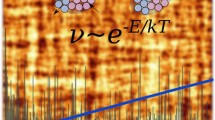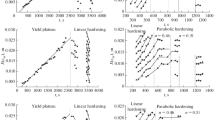Abstract
We formulate a generic concept model for the deformation of a locally disordered, macroscopically homogeneous material which undergoes irreversible strain softening during plastic deformation. We investigate the influence of the degree of microstructural heterogeneity and disorder on strain localization (formation of a macroscopic shear band) in such materials. It is shown that increased microstructural heterogeneity delays strain localization and leads to an increase of the plastic regime in the macroscopic stress–strain curves. The evolving strain localization patterns are characterized.







Similar content being viewed by others
References
Adibi S, Sha Z, Branicio P, Joshi SP, Liu Z, Zhang Y (2013) A transition from localized shear banding to homogeneous superplastic flow in nanoglass. Appl Phys Lett 103(211):905
Albaret T, Tanguy A, Boioli F, Rodney D (2016) Mapping between atomistic simulations and Eshelby inclusions in the shear deformation of an amorphous silicon model. Phys Rev E 93(053):002. doi:10.1103/PhysRevE.93.053002
Albe K, Ritter Y, Sopu D (2013) Shear band formation, nanocomposites and nanoglasses investigated by molecular dynamics simulations. Mech Mater 67:94–103
Ashby M, Greer A (2006) Metallic glasses as structural materials. Scripta Mater 54(3):321–326. doi:10.1016/j.scriptamat.2005.09.051
Bako B, Groma I, Györgyi G, Zimanyi G (2006) Dislocation patterning: the role of climb in meso-scale simulations. Comput Mater Sci 38:22–28
Budrikis Z, Zapperi S (2013) Avalanche localization and crossover scaling in amorphous plasticity. Phys Rev E 88(062):403. doi:10.1103/PhysRevE.88.062403
Cheng Y, Cao A, Ma E (2009) Correlation between the elastic modulus and the intrinsic plastic behavior of metallic glasses: the roles of atomic configuration and alloy composition. Acta Mater 57(11):3253–3267. doi:10.1016/j.actamat.2009.03.027
Das J, Tang M, Kim KB, Theissmann R, Baier F, Wang WH, Eckert J (2005) “Work-hardenable” ductile bulk metallic glass. Phys Rev Lett 94(205):501
Groma I, Csikor F, Zaiser M (2003) Spatial correlations and higher-order gradient terms in a continuum description of dislocation dynamics. Acta Mater 51(5):1271–1281. doi:10.1016/S1359-6454(02)00517-7
Hofmann DC, Suh JY, Wiest A, Duan G, Lind ML, Demetriou MD, Johnson W (2008) Designing metallic glass matrix composites with high toughness and tensile ductility. Nature 451:1085–1089
Ispánovity PD, Ádám Hegyi, Groma I, Györgyi G, Ratter K, Weygand D (2013) Average yielding and weakest link statistics in micron-scale plasticity. Acta Mater 61(16):6234–6245. doi:10.1016/j.actamat.2013.07.007
Kapetanou O, Weygand D, Zaiser M (2015) Stress and strain fluctuations in plastic deformation of crystals with disordered microstructure. J Stat Mech Theory Exp P08009
Lennartz-Sassinek S, Main IG, Zaiser M, Graham CC (2014) Acceleration and localization of subcritical crack growth in a natural composite material. Phys Rev E 90(052):401. doi:10.1103/PhysRevE.90.052401
Lin J, Saade A, Lerner E, Rosso A, Wyart M (2014) On the density of shear transformations in amorphous solids. EPL (Europhys Lett) 105(2):26003
Lin J, Gueudre T, Rosso A, Wyart M (2015) Criticality in the approach to failure in amorphous solids. Phys Rev Lett 115:168,001. doi:10.1103/PhysRevLett.103.065501
Qiao J, Yao Y, Pelletier J, Keer L (2016) Understanding of micro-alloying on plasticity in \(\text{CU}_{46}\text{ Zr }_{47}{-}x\text{ Al }_7dyx 0 \leqslant x \leqslant 8\) bulk metallic glasses under compression: based on mechanical relaxations and theoretical analysis. Int J Plast doi:10.1016/j.ijplas.2016.02.002S0749641916300122
Rodney D, Schuh C (2009) Distribution of thermally activated plastic events in a flowing glass. Phys Rev Lett 102(235):503
Rodney D, Tanguy A (2011) Modeling the mechanics of amorphous solids at different length scale and time scale. Modell Simul Mater Sci Eng 19(083):001
Sandfeld S, Budrikis Z, Zapperi S, Fernandez Castellanos D (2015) Avalanches, loading and finite size effects in 2D amorphous plasticity: results from a finite element model. J Stat Mech Theory Exp 2015(2):P02011
Schuh CA, Hufnagel TC, Ramamurty U (2007) Mechanical behavior of amorphous alloys. Acta Mater 55:4067–4109
Şopu D, Ritter Y, Gleiter H, Albe K (2011) Deformation behavior of bulk and nanostructured metallic glasses studied via molecular dynamics simulations. Phys Rev B 83(100):202. doi:10.1103/PhysRevB.83.100202
Steif P, Spaepen F, Hutchinson JW (1982) Strain localization in amorphous metals. Acta Metall 30(2):447–455
Talamali M, Petäjä V, Vandembroucq D, Roux S (2012) Strain localization and anisotropic correlations in a mesoscopic model of amorphous plasticity. C R Mécanique 340(4–5):275–288. doi:10.1016/j.crme.2012.02.010 (recent Adv Micromech Mater)
Wright W, Schwarz RB, Nix W (2001) Localized heating during serrated plastic flow in bulk metallic glasses. Mater Sci Eng A 319:229–232
Wu Y, Bei H, Wang Y, Lu Z, George E, Gao Y (2015) Deformation-induced spatiotemporal fluctuation, evolution and localization of strain fields in a bulk metallic glass. Int J Plast 71:136–145. doi:10.1016/j.ijplas.2015.05.006
Xu X, Wang Y, Guo A, Geng H, Ren S, Tao X, Liu J (2016) Enhanced plasticity by nanocrystallite in bulk amorphous \(\text{ AL }_2\text{ O }_3{-}\text{ ZrO }_2--\text{ Y }_2\text{ O }_3\). Int J Plast 79:314–327. doi:10.1016/j.ijplas.2015.09.004
Zaiser M (2006) Scale invariance in plastic flow of crystalline solids. Adv Phys 55:185–245
Zaiser M, Mill F, Konstantinidis A, Aifantis K (2013) Strain localization and strain propagation in collapsible solid foams. Mater Sci Eng A 567:38–45
Zaiser M, Aifantis EC (2006) Randomness and slip avalanches in gradient plasticity. Int J Plast 22(8):1432–1455. doi:10.1016/j.ijplas.2005.07.010 (special issue in honour of Dr. Kirk Valanis)
Zaiser M, Moretti P (2005) Fluctuation phenomena in crystal plasticity—a continuum model. J Stat Mech Theory Exp 2015(08):P08004
Zhou H, Zhong C, Cao Q, Qu S, Wang X, Yang W, Jiang J (2014) Non-localized deformation in metallic alloys with amorphous structure. Acta Mater 68:32–41
Acknowledgements
Financial support of the Hungarian Scientific Research Fund (OTKA) under contract number PD-105256 and of the European Commission under Grant Agreement No. CIG-321842 are also acknowledged. DT is supported by a One Year scholarship program sponsored by the Free State of Bavaria for graduates of Central, Eastern and Southeastern European states. PDI is also supported by the János Bolyai Scholarship of the Hungarian Academy of Sciences. MZ acknowledges financial support of DFG under Grant No. Za171/8-1.
Author information
Authors and Affiliations
Corresponding author
Appendix
Appendix
In our evaluation of internal stresses we use that the evaluation of stresses in any plane strain deformation problem can be mapped onto the evaluation of the stress field of a 2D dislocation arrangement consisting of straight parallel edge dislocations with line direction perpendicular to the considered plane. In particular, the shear stress field \(\sigma _{xy}({\varvec{r}}) =: \tau ({\varvec{r}})\) generated by a two dimensional distribution of dislocations with Burgers vector parallel to the x axis, line direction along the z axis, and Burgers vector density \(\alpha \) can be expressed as
where \(\tau _\mathrm{ind}\) is the shear stress field created by a dislocation of unit Burgers vector length,
Due to the relation \(\alpha = - {\partial _x}{\gamma \left( {{{\varvec{r}}}} \right) }\) (Groma et al. 2003), the shear stress field can then be expressed in terms of the shear strain field as
By a partial integration one obtains
Here \({\partial _x}{\tau _{{\text {ind}}}}\left( {{{{\varvec{r}}}}} \right) = {G^E}\) is the Green’s function which allows to calculate the shear stress by convolution with the strain.
We now need to adapt the above reasoning to a discrete lattice system with periodic boundary conditions. In doing so we aim at a correct representation on large scales, and at a correct representation of the symmetries of the Green’s function, but not at a faithful representation of the shearing process inside a single grid cell (which cannot be represented anyway in a lattice based simulation). Thus we calculate the stress and strain fields generated by an elementary slip event in a cell as follows (Fig. 8 illustrates the calculation.) The cell under deformation is cut along the x and y direction. The upper part is moved by a distance b along the x direction and the right side is moved by b along the y direction, according to the sign of the shear stress acting on the cell. Then, the four parts are glued back together. Next, an elastic deformation is applied which transforms the cell back to its original shape so it fits its original place in the sample. The cell is placed back to its original position and the sample is elastically relaxed. The average plastic strain generated by this process in the cell is \(\varDelta \gamma ^\mathrm{pl} = 2b/d\).
The process is formally equivalent to adding four edge dislocations with the respective virtual Burgers vectors \(b{{\varvec{e}}_{x}}\), \(b{{\varvec{e}}_{y}}\), \(-b{{\varvec{e}}_{x}}\), \(-b{{\varvec{e}}_{y}}\) at the centerpoints of the right, top, left and bottom sides of the cell. Accordingly, the stress field can be evaluated as the superposition of the stress fields of these four dislocations. Periodic boundary conditions are implemented by adding to the stress fields of the four dislocations those of their periodic images which form an infinite lattice of period L (for details of the method used for evaluating the lattice sum, see Bako et al. 2006). We evaluate stresses at the cell centerpoints, hence, the stress field induced by a elementary slip event \(\varDelta {\gamma ^{{\text {pl}}}}\) at the centerpoint of the active cell is obtained from summation of the stress fields of the four edge dislocations as \(G_{0,0}^E\varDelta {\gamma ^{{\text {pl}}}} = - 2\mu \varDelta {\gamma ^{{\text {pl}}}}/\left[ {\pi \left( {1 - \nu } \right) } \right] \) where \(\mu \) is the shear modulus and \(\nu \) is Poisson’s ratio. The result is shown in Fig. 9.
The stress field of a unit slip event located in the origin in the units of \(\left| {G_{0,0}^E} \right| \), assuming periodic boundary conditions with \(L = 32\). Note the symmetry in the x and y directions and the logarithmic color scale. In the upper right corner we show a magnification for \(k \in \left[ {0,2} \right] , l\in \left[ {0,2} \right] \)
We emphasize that the use of dislocations to evaluate internal stresses is, in our present context, a mere computational device which allows us to treat the periodic boundary conditions in a simple and efficient manner, but which does not necessarily reflect the physical processes which govern the elementary slip event \(\varDelta {\gamma ^{{\text {pl}}}}\) (e.g., in the context of amorphous materials, this could be a shear transformation which does not involve any dislocations).
Rights and permissions
About this article
Cite this article
Tüzes, D., Ispánovity, P.D. & Zaiser, M. Disorder is good for you: the influence of local disorder on strain localization and ductility of strain softening materials. Int J Fract 205, 139–150 (2017). https://doi.org/10.1007/s10704-017-0187-1
Received:
Accepted:
Published:
Issue Date:
DOI: https://doi.org/10.1007/s10704-017-0187-1






